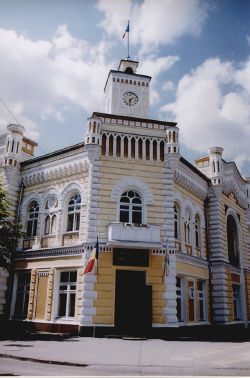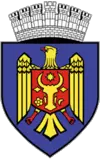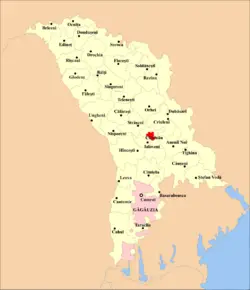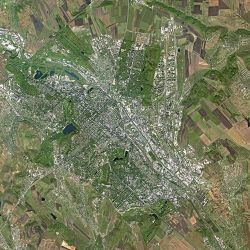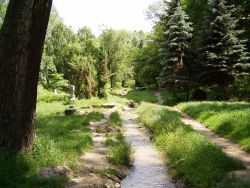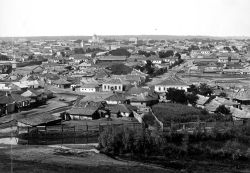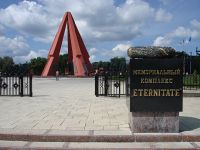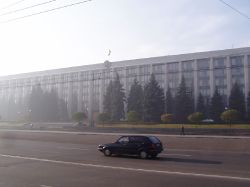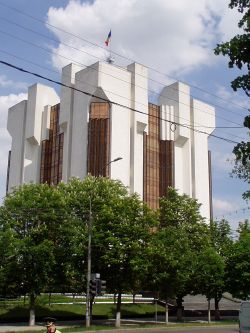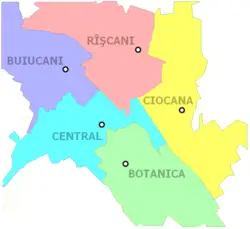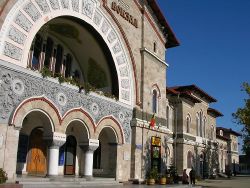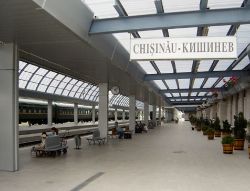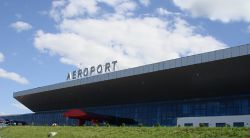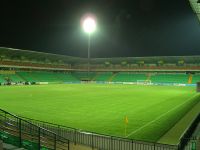Difference between revisions of "Chişinău" - New World Encyclopedia
Mike Butler (talk | contribs) |
Mike Butler (talk | contribs) |
||
| Line 83: | Line 83: | ||
After the Russian [[October Revolution]] in 1917, Bessarabia was declared an autonomous constituent republic of the Federation of Russian Republics. Disorder caused by revolutionary Russian soldiers prompted Bessarabia to seek Romanian military help. The Russian Bolshevik revolutionary army occupied Chisinau in January 1918. Romanian forces drove the Bolsheviks out within two weeks, and on February 6, Bessarabia was declared an independent Moldavian republic, cutting ties with Russia. Bessarabia united with the Kingdom of Romania the same year. | After the Russian [[October Revolution]] in 1917, Bessarabia was declared an autonomous constituent republic of the Federation of Russian Republics. Disorder caused by revolutionary Russian soldiers prompted Bessarabia to seek Romanian military help. The Russian Bolshevik revolutionary army occupied Chisinau in January 1918. Romanian forces drove the Bolsheviks out within two weeks, and on February 6, Bessarabia was declared an independent Moldavian republic, cutting ties with Russia. Bessarabia united with the Kingdom of Romania the same year. | ||
| − | + | Chişinău was regarded as no more than a large provincial city. The area was quickly industrialized. Industrialization prompted growth. Between 1918 and 1940 the center of the city undertook large [[renovation]] work. In 1927, a monument to prince [[Stephen III of Moldavia]] was erected. | |
===World War II=== | ===World War II=== | ||
Revision as of 23:43, 24 August 2008
| Chişinău | |||
| Chişinău city hall | |||
|
|||
| Location of Chişinău in Moldova | |||
| Coordinates: {{#invoke:Coordinates|coord}}{{#coordinates:47|0|00|N|28|55||E|type:city | |||
|---|---|---|---|
| name= }} | |||
| Country | Moldova | ||
| Founded | 1436 | ||
| Government | |||
| - Mayor | Dorin Chirtoacă, since 2007 | ||
| Area | |||
| - City | 120 km² (46.3 sq mi) | ||
| - Urban | 635 km² (245.2 sq mi) | ||
| Elevation | 85 m (279 ft) | ||
| Population (2007) | |||
| - City | 592,900 | ||
| - Density | 4,938/km² (12,789.4/sq mi) | ||
| - Urban | 785,000 | ||
| - Metro | 911,400 | ||
| Time zone | EET (UTC+2) | ||
| - Summer (DST) | EEST (UTC+3) | ||
| Postal code | MD-20xx | ||
| Area code(s) | +373 22 | ||
| Website: www.chisinau.md | |||
Chişinău (IPA: [ki.ʃi.'nəw]) (also known as Kishinev, Russian: Кишинёв, Kishinyov), is the capital city and industrial and commercial center of Moldova. It is also the largest city of Moldova and is located in the center of the country, on the river Bîc. Economically, the city is the most prosperous in Moldova and is one of the main industrial centers and transportation hubs of the region. Additionally, the city has among the highest proportion of green spaces of any major city in Europe.
Geography
The name could come from the old Romanian word chişla ("spring" or "source of water")[1] and nouă ("new"), because it was built around a small spring. The spring is located at the corner of Pushkin St and Albişoara St. The English language name for the city was based on the modified Russian "Kishinev" since it entered the English language at the time Chişinău was part of the Russian Empire.
The city is located on the river Bîc, a tributary of the Dniester, in the middle of the central area of Moldova. The city is surrounded by a relatively level landscape with fertile ground, used for cultivating grapevines and fruit since medieval times.
The lowest point in Moldova is the Dniester River 6.5 feet (two meters). The city has an area of 46.3 square miles (120 square kilometers). The whole municipality covers 635 square kilometers.
Chişinău has a continental climate, characterized by hot dry summers and cold windy winters. The average maximum daytime temperature in January (winter) is 40°F (4°C), although temperatures often dip below 0°C (32°F). The average summer maximum of around 81°F (27°C) in July. Mean annual precipitation is 63 inches (1600mm), higher in spring and autumn, with infrequent yet heavy storms in summer.
Many streets of Chişinău are named after historic persons, places or events. Independence from the Soviet Union was followed by a large-scale renaming of streets and localities from a Communist theme into a national one.
History
Founded in 1436 as a monastery town, the city was part of the Moldavian Principality, which, starting with the 16th century fell under the suzerainty of the Ottoman Empire. At the beginning of the 19th century it was a small town of 7000 inhabitants. In 1812 it was came under Russian imperial administration, which made it the capital of the newly annexed gubernia of Bessarabia. Its population had grown to 92,000 by 1862 and to 125,787 by 1900.
From 1834 an imperial townscape, with broad and long roads, emerged as a result of a generous town development plan, which divided the city roughly into two areas. The old part of the town - with its irregular building structures - and a newer City Center and station.
Between May 26, 1830, and October 13, 1836, the architect Avraam Melnikov established the 'Catedrala Naşterea Domnului' (an Orthodox Cathedral) with a magnificent bell tower. In 1840 the building of the Triumphal Arch, planned by the architect, Luca Zauşkevici, was completed. Following this the construction of numerous further buildings and landmarks began. The town also played an important part in the war between Russia and Turkey (1877–78), as the chief center of the Russian invasion.
Pogrom
Growing anti-semitic sentiment in Russia in the late 19th century meant that many Jews settled in Chişinău. By 1900, 43 percent of the population of Chişinău was Jewish - one of the highest numbers in Europe. However, in April 1903[2] anti-Jewish articles in the the only official newspaper sparked three days of anti-Semitic rioting took place, in which about 49 Jews were killed, 92 severely wounded, and 500 suffered minor injuries. Hundreds of houses and many businesses were plundered and destroyed. The killings prompted US President Theodore Roosevelt to petition Tsar Nicholas II of Russia on behalf of the American people in July 1905. On August 22, 1905, police opened fire on an estimated 3000 demonstrating agricultural workers. In October of that year, a further protest turned into an attack on Jews, resulting in 19 deaths.
Independence
After the Russian October Revolution in 1917, Bessarabia was declared an autonomous constituent republic of the Federation of Russian Republics. Disorder caused by revolutionary Russian soldiers prompted Bessarabia to seek Romanian military help. The Russian Bolshevik revolutionary army occupied Chisinau in January 1918. Romanian forces drove the Bolsheviks out within two weeks, and on February 6, Bessarabia was declared an independent Moldavian republic, cutting ties with Russia. Bessarabia united with the Kingdom of Romania the same year.
Chişinău was regarded as no more than a large provincial city. The area was quickly industrialized. Industrialization prompted growth. Between 1918 and 1940 the center of the city undertook large renovation work. In 1927, a monument to prince Stephen III of Moldavia was erected.
World War II
In the chaos of the Second World War (1939-1945) Chişinău was nearly destroyed. This began with the Soviet occupation led by the Red Army on June 28, 1940. As the city began to recover from the takeover, a devastating earthquake occurred on November 10, 1940. The epicenter of the quake, which measured 7.3 on the Richter scale, was in eastern Romania and led to substantial destruction in the city.
After scarcely one year, the assault on the newly created Moldovan SSR by the German and Romanian armies began. Beginning with July 1941 the city suffered from large-scale shooting and heavy bombardments by Nazi air raids. The Red Army resistance held until Chişinău finally fell on 17 July 1941.
Following the occupation, the city suffered from the characteristic mass murder of predominantly Jewish inhabitants. As had been seen elsewhere in Europe, the Jews were transported on trucks to the outskirts of the city and then shot in partially dug pits. The number of Jews murdered during the occupation of the city is estimated at approximately 10,000 people.[3]
As the war drew to a conclusion, the city was once more pulled into heavy fighting as German troops retreated. Chişinău was taken by the Red Army on 24 August 1944 as a result of the Jassy-Kishinev Operation. By this point the city had lost about 70% of its buildings - the earthquake of 1940 and the air raids contributing to the largest part of this.
After the war, Bessarabia was fully integrated into the Soviet Union. Most of Bessarabia became the Moldavian SSR with Chişinău as its capital; smaller parts of Bessarabia became parts of the Ukrainian SSR.
Soviet Union
In the years 1947 to 1949 the architect Alexey Shchusev developed a plan with the aid of a team of architects for the gradual reconstruction of the city.
The beginning of the 1950s saw a rapid population growth, to which the Soviet administration responded by constructing large-scale housing and palaces in the style of Stalinist architecture. This process continued under Nikita Khrushchev, who called for construction under the slogan "good, cheaper and built faster". The new architectural style brought about dramatic change and generated the style that dominates today, with large blocks of flats arranged in considerable settlements.
The period of the most significant redevelopment of the city extended from 1971, when the Council of Ministers of the Soviet Union adopted a decision "On the measures for further development of the city of Kishinev", which secured more than one billion rubles in investment from the state budget, until 1991, when Moldova gained independence, after a series of Moldovan nationalistic riots against the Russian-speaking population (Russians, Ukranians, Jews, Gagauz and others).
Government
Moldova is a republic in which the president, who is elected by parliament for a four-year term, is the chief of state, and the prime minister, who is designated by the president upon consultation with parliament, is head of government. The unicameral parliament has 101 members elected by popular vote to serve four-year terms.
Moldova is administratively subdivided in 32 districts, two autonomous units, and three municipalities. Chişinău is one of the municipalities. Besides the city itself, the municipality comprises 34 other suburban localities, and is subdivided into five sectors, each comprising a part of the city itself and several suburbs. The municipality elects a mayor and a local council, which then name five pretors, one for each sector. The five sectors of Chişinău are: Botanica, Buiucani, Centru, Ciocana, and Râşcani.
Chişinău is governed by the city council and the city mayor (Romanian: Primar), both elected once every four years. The first mayor of Chişinău was Angel Nour in 1817. In 1941 the office was abolished. After the Soviet era and the re-establishment of the office in 1990 Nicolae Costin became the first democratically elected mayor.
Economy
Moldova remains one of the poorest countries in Europe. With a favorable climate and good farmland, but without major mineral deposits, the economy depends heavily on agriculture, featuring fruits, vegetables, wine, and tobacco. Chişinău is the most economically-developed and industrialized city in Moldova. The city's economy focuses on industry and services, with services growing in importance in the 10 years to 2008.
Its main industries include consumer and electrical goods, building materials, machinery, plastics, rubber, and textiles. The main service fields are banking and shopping/commerce.
Most of Moldova's media industry is based in Chişinău.
Per capita GDP, rank
Tourism
The most popular form of internal transport in Moldova is generally by bus, which can be inexpensive. From 1994, new trolleybus lines were built, and the capacity of existing lines increased. Within Chişinău, privately-operated minibuses, known as "maxi-taxis," follow the major bus routes. Taxis are widely used.
An international railway terminal has connections to Bucharest, Kiev, Minsk, Odessa and Moscow, although conflict with the unrecognized Transnistria republic disrupts rail traffic towards Ukraine.
The Chişinău International Airport offers connections to a number of European cities, and handled 689,000 passengers in 2007.
Demographics
Total population: 647,513[4]
Race/ethnicity - historical background of ethnic groups The census held in 2004 reported the following ethnic composition:[5]
- 67.6% Moldovans
- 13.9% Russians
- 8.3% Ukrainians
- 4.5% Romanians
- 1.2% Bulgarians
- 0.9% Gagauzians
- 1.6% others
- 1.9% undeclared
Language Religion Colleges and universities
The city is home to 12 public and 11 private universities, to the Academy of Sciences of Moldova, as well as to a number of institutions offering both high-school education, as well as 1-2 years of college education.
Since the collapse of the Soviet Union, the city has become a relatively lively and well-provisioned capital, with a much higher standard of living than most rural areas.
Of interest
In the XIX-th century the plan of growth of the city was developed. Many buildings were designed and built in a beautiful architectural frame, a lot of which embellish the city till nowadays. In 1836 the construction of the Cathedral and Belfry was finished.
During soviet time, the Belfry was demolished and only after regaining the independence, following the initiative of renowned people, the Municipality of Chisinau and thousands of citizens, the Belfry was rebuilt and the Cathedral was renovated.
Actually, a lot of modern styled buildings are built in the city. As usual there is the living blocks. There are also a lot of office and shopping modern renovated or new built complexes. These are Kentford, SkyTower, Union Fenosa headquarter, etc.
Sport
There are four professional football clubs in Chişinău, all playing in the Divizia Naţională (national league): FC Zimbru Chişinău, FC Dacia Chişinău, FC Politehnica Chişinău and CSCA-Steaua Chişinău, ranked respectively 4th, 5th, 7th and 8th tn the 2004/5 season. Of the larger football stadiums in the city, the Stadionul Republican (Republican Stadium) has 7687 seats[6] and the Stadionul Dinamo (Dinamo Stadium) has a capacity of 2,692. The Zimbru stadium, opened in May 2006 with a capacity of 10,500 siting places, meets all the requirements for holding official international matches. The Republican Stadium has been designated as the venue for Moldova's Euro 2008 for the qualifying matches.
Music and nightlife
Chişinău is home to Moldova's largest recording labels, and is often the residence of Moldovan, and more recently Ukrainian, musicians. The city's music scene is quite eclectic. Many Moldovan rock bands of the 1970s and 1980s continue to be popular, particularly with the middle-aged, while since the 1990s there has been growth in the boy band and hip hop genres. A famous band, Lăutarii, was established and also operates successfully in Chişinău. There is also a renowned dance group, Codreanca, which participates and wins prizes in international festivals.
Gallery
- Vorota kishineva.jpg
"Gates of the city", Chişinău, Moldova
Notes
- ↑ Istoria Kishinev.info Retrieved 2006, 11-28
- ↑ Virtual Kishinev, accessed 23 December 2007
- ↑ "Memories of the Holocaust: Kishinev (Chisinau) (1941-1944)" from jewishvirtuallibrary.org
- ↑ Moldova: largest cities and towns and statistics of their population World Gazetteer
- ↑ 2004 census results in Moldova
- ↑ Moldova on UEFA website. Accessed 9 November 2006.
Further reading
- Hamm, Michael F. (March 1998). Kishinev: The character and development of a Tsarist Frontier Town. Nationalities Papers 26 (1): 19–37.
External links
Template:WikinewsPortalMoldova
- www.chisinau.md - official site of Chişinău (Romanian);
- www.virtualchisinau.com - Chisinau photo gallery by districts and other useful information (Romanian), (English);
- cam.info.md - Chisinau Live Webcam some information in (Romanian), (English), (Russian);
- Old (1995) Chişinău Photo-Gallery - a lot of artistic photos;
- Chişinău telephone directory (primarily in (Russian), some minimal content in (English), (French), (German));
- Jewish community of Chişinău (English).
- Travel guide to Chişinău from Wikitravel
Maps
- Interactive Map of Chişinău (en, ro, ru)
- Map of Chişinău
-
- Mapping from Multimap or GlobalGuide or Google Maps
- Satellite image from WikiMapia
- Mapping from OpenStreetMap
Credits
New World Encyclopedia writers and editors rewrote and completed the Wikipedia article in accordance with New World Encyclopedia standards. This article abides by terms of the Creative Commons CC-by-sa 3.0 License (CC-by-sa), which may be used and disseminated with proper attribution. Credit is due under the terms of this license that can reference both the New World Encyclopedia contributors and the selfless volunteer contributors of the Wikimedia Foundation. To cite this article click here for a list of acceptable citing formats.The history of earlier contributions by wikipedians is accessible to researchers here:
The history of this article since it was imported to New World Encyclopedia:
Note: Some restrictions may apply to use of individual images which are separately licensed.
